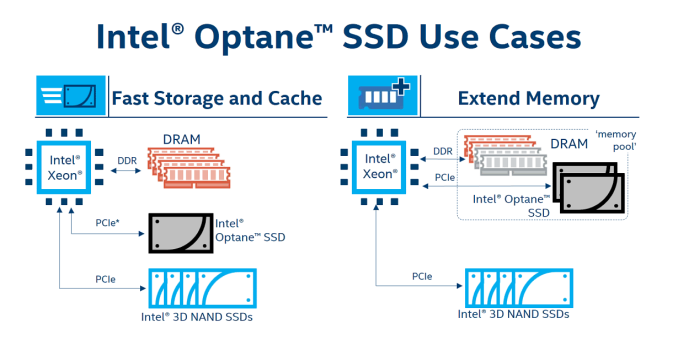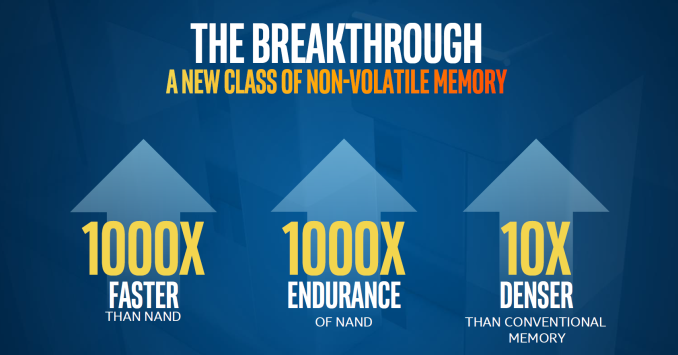Intel and Micron To Dissolve 3D XPoint Partnership After 2019
by Ian Cutress on July 16, 2018 6:35 PM EST
A press release from Intel today has clarified the state of the 3D XPoint Joint Venture the company has with Micron. Currently Intel and Micron co-developed the new class of non-volatile memory, with manufacturing at the Intel-Micron Flash Technologies (IMFT) fab in Utah. Intel’s statement today states that for the second generation of memory, the development will also be a joint effort and is expected to complete in the first half of 2019. However the third generation will be developed independently, allowing each company to focus on the separate business needs.
3D XPoint technology, branded as Optane by Intel and QuantX by Micron, has been a mini-revolution when it comes to non-volatile memory. Intel’s Optane products, mostly storage but with recent announcements about DRAM, have seen a sizeable uptick in interest from specific enterprise markets that can benefit from persistant data or fast random access storage. Intel is expected to launch its DRAM products alongside its next generation server architecture at some point in the new future. Under the terms of the joint venture, each company gets 50% of the flash memory made at the IMFT fab in Utah. Micron’s QuantX has not been released, which raises the question as to who has been buying it.
Intel has long held that 3D XPoint has a long life ahead of it, offering speed, density, and a wide range of applications. The industry is still waiting to be fully exposed to Intel’s initial promises about the product, from storage to memory, but also future generations of the product, such as adding layers and capacity. As with all technologies, these things are generational, and today’s announcement states that Intel and Micron are still working jointly with the second generation product. The completion of second generation 3D XPoint is expected in the first half of 2019, but then R&D focus will shift to completing and finalizing the third generation. It is this generation that is the focus of the announcement: the companies will no longer work together for it. This means that both companies will have a chance to adjust their roadmaps independently, either pursing a more aggressive strategy, or none at all. The note also states that the memory will continue to be built in the same fab, which raises questions as to how the joint venture will work in that case, if the research is done independently.
Both Intel and Micron have been having problems of late, with Intel’s Optane DRAM being released later than originally promised, and Micron having issues with the Chinese government, as well as disappointing sales of its own 3D XPoint. At least some clarity is being given to the 3D XPoint side of the businesses, if only to shine a light on the nature of the agreement for the next few years.
Related Reading
- Intel Launches Optane DIMMs Up To 512GB: Apache Pass Is Here!
- Micron Update (Q2'18): 96L 3D NAND, Sales of 3D XPoint Disappoint
- The Intel Optane SSD DC P4800X (375GB) Review: Testing 3D XPoint Performance
- Micron Announces QuantX Branding For 3D XPoint Memory
- Analyzing Intel-Micron 3D XPoint: The Next Generation Non-Volatile Memory
Source: Intel

















19 Comments
View All Comments
brakdoo - Tuesday, July 17, 2018 - link
Yeah, but Micron probably won't get access to Intel's proprietary DIMM interfaces for Optane (non-Jedec). So data center for Micron can only mean PCIe or U.2 but that's a tough market...I'd rather see XPoint as cache in UFS packages and SSDs replacing DRAM and pseudo-SLC mode.
Yojimbo - Tuesday, July 17, 2018 - link
I don't see why Micron would enter into a joint venture with Intel and develop a memory technology with a roadmap for two methods of deployment, both DIMMs and SSDs, without gaining access to the IP necessary for both deployments. Just because Micron has thus far chosen not to release any 3D XPoint products doesn't mean they aren't fully capable of doing so. I'd be willing to bet that Micron will be able to market 3D XPoint DIMMs on both Intel and non-Intel platforms (such as OpenPower).wumpus - Wednesday, July 18, 2018 - link
More likely Intel will gladly give access to such DIMMS in return for promises to never sell anything but "Intel only" memory or current PCIe access. The last thing they want is Micron publishing a DDRish spec that AMD and ARM could use.If Intel is trying to use a server CPU monopoly to extend to a server memory monopoly it could easily backfire. On the other hand they could easily sacrifice half the potential server memory market to maintain their server CPU market.
"A bird in the hand is worth two in the bush"
Yojimbo - Wednesday, July 18, 2018 - link
I'd be very surprised if Micron doesn't have the power to bring 3D XPoint fully to non-Intel platforms. Micron is a founding member of the OpenPower Consortium and surely would want to sell 3D XPoint in OpenPower servers and supercomputers.Intel does not have a server CPU monopoly, anyway. They simply have a dominant market share. There's a difference. I really doubt Micron entered into the joint venture in a way that severely limited its ability to profit from what it was developing. If Intel loses market share, a possibility Micron would have been astutely aware of, Micron would have wanted to have the ability to market 3D XPoint to the non-Intel market as well.
wumpus - Wednesday, July 18, 2018 - link
Intel absolutely doesn't want Xpoint to replace DRAM (which is what it would be doing in the datacenter). The price of RAM in those servers is huge, which means you pay for the most powerful server you can buy and you don't look at the price tag (until it gets higher than the DRAM). This allows Intel to jack their prices sky-high as nobody has competed with them for a long time. Now they not only need to fear EPYC, but suddenly the performance bar that ARM needs to clear to make a "server worthy" CPU for "optane memory" is far lower (and ARM servers are showing up which have some serious performance).Intel is trying to figure out how to put the genie back in the bottle (they may have to buy Micron out. Or maybe the whole thing won't work after all.)
iwod - Tuesday, July 17, 2018 - link
So what exactly is new in the 2nd Gen Optane? Speed ? Power? Price?brakdoo - Tuesday, July 17, 2018 - link
More than two (mirrored) layers. It was supposed to go much higher than now to bring costs significantly down.danielfranklin - Wednesday, July 18, 2018 - link
Exactly.Early NAND wasnt very good either.
If they can double the performance and halve the cost in one generation, we will have something VERY interesting on our hands....
ktraj1@gmail.com - Wednesday, July 25, 2018 - link
No way SCM can replace DRAM. It can just complement. Maybe MCS can do but only time will tell. When QuantX, Optane news came up, all and sundry expect a lot. But it falters. MRA, ReRam, PCM may look to be more at an embryonic stage, yet to be hatched into a sea of monstrous competitions.